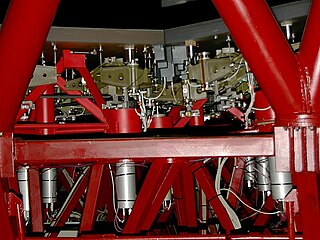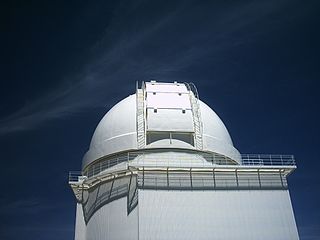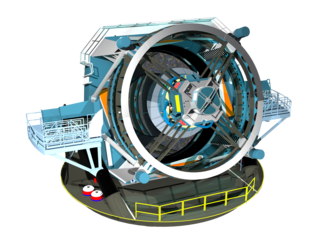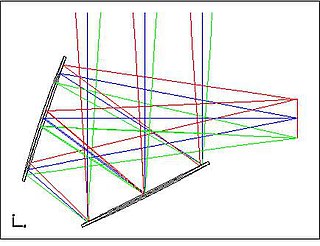Related Research Articles

The Very Large Telescope (VLT) is a telescope facility operated by the European Southern Observatory on Cerro Paranal in the Atacama Desert of northern Chile. The VLT consists of four individual telescopes, each with a primary mirror 8.2 m across, which are generally used separately but can be used together to achieve very high angular resolution. The four separate optical telescopes are known as Antu, Kueyen, Melipal, and Yepun, which are all words for astronomical objects in the Mapuche language. The telescopes form an array which is complemented by four movable Auxiliary Telescopes (ATs) of 1.8 m aperture.

The Overwhelmingly Large Telescope (OWL) was a conceptual design by the European Southern Observatory (ESO) organization for an extremely large telescope, which was intended to have a single aperture of 100 meters in diameter. Because of the complexity and cost of building a telescope of this unprecedented size, ESO has elected to focus on the 39-meter diameter Extremely Large Telescope instead.

Subaru Telescope is the 8.2-meter (320 in) flagship telescope of the National Astronomical Observatory of Japan, located at the Mauna Kea Observatory on Hawaii. It is named after the open star cluster known in English as the Pleiades. It had the largest monolithic primary mirror in the world from its commissioning until 2005.

Active optics is a technology used with reflecting telescopes developed in the 1980s, which actively shapes a telescope's mirrors to prevent deformation due to external influences such as wind, temperature, mechanical stress. Without active optics, the construction of 8 metre class telescopes is not possible, nor would telescopes with segmented mirrors be feasible.

The WIYN Observatory is owned and operated by the WIYN Consortium. Its 3.5-meter telescope is the second largest optical telescope at Kitt Peak National Observatory in Arizona. Most of the capital costs for the observatory were provided by the University of Wisconsin–Madison, Indiana University, and Yale University, while the National Optical Astronomy Observatory (NOAO) provides most of the operating services. The NOAO is an institution of the United States; it is the national optical observatory program and supports a collection of ground-based telescopes at Kitt Peak as well as other locations.

The Swedish 1-m Solar Telescope is a refracting solar telescope at Roque de los Muchachos Observatory, La Palma in the Canary Islands. It is run by the Institute for Solar Physics of Stockholm University. The primary element is a single fused silica lens, making it the second largest optical refracting telescope in use in the world. The 110-cm lens has a clear aperture diameter of 98 cm. The SST is most often used as a Schupmann telescope, thereby correcting the chromatic aberrations of the singlet primary.

The Giant Magellan Telescope (GMT) is a ground-based extremely large telescope under construction. It will consist of seven 8.4 m (27.6 ft) diameter primary segments, that will observe optical and near infrared (320–25000 nm) light, with the resolving power of a 24.5 m (80.4 ft) primary mirror and collecting area equivalent to a 22.0 m (72.2 ft) one, which is about 368 square meters. The telescope is expected to have a resolving power 10 times greater than the Hubble Space Telescope. As of November 2017, five mirrors had been cast and the construction of the summit facility has begun.

The Navy Precision Optical Interferometer (NPOI) is an American astronomical interferometer, with the world's largest baselines, operated by the Naval Observatory Flagstaff Station (NOFS) in collaboration with the Naval Research Laboratory (NRL) and Lowell Observatory. The NPOI primarily produces space imagery and astrometry, the latter a major component required for the safe position and navigation of all manner of vehicles for the DoD. The facility is located at Lowell's Anderson Mesa Station on Anderson Mesa about 25 kilometers (16 mi) southeast of Flagstaff, Arizona (US). Until November 2011, the facility was known as the Navy Prototype Optical Interferometer (NPOI). Subsequently, the instrument was temporarily renamed the Navy Optical Interferometer, and now permanently, the Kenneth J. Johnston Navy Precision Optical Interferometer (NPOI) – reflecting both the operational maturity of the facility, and paying tribute to its principal driver and retired founder, Kenneth J. Johnston.

The Calar Alto Observatory is an astronomical observatory located in Almería province in Spain on Calar Alto, a 2,168-meter-high (7,113 ft) mountain in the Sierra de Los Filabres range.

The Vera C. Rubin Observatory, previously referred to as the Large Synoptic Survey Telescope (LSST), is an astronomical observatory currently under construction in Chile. Its main task will be an astronomical survey, the Legacy Survey of Space and Time (LSST). The Rubin Observatory has a wide-field reflecting telescope with an 8.4-meter primary mirror that will photograph the entire available sky every few nights. The word synoptic is derived from the Greek words σύν and ὄψις, and describes observations that give a broad view of a subject at a particular time. The observatory is named for Vera Rubin, an American astronomer who pioneered discoveries about galaxy rotation rates.

The United States Naval Observatory Flagstaff Station (NOFS), is an astronomical observatory near Flagstaff, Arizona, US. It is the national dark-sky observing facility under the United States Naval Observatory (USNO). NOFS and USNO combine as the Celestial Reference Frame manager for the U.S. Secretary of Defense.

A null corrector is an optical device used in the testing of large aspheric mirrors. A spherical mirror of any size can be tested relatively easily using standard optical components such as laser, mirrors, beamsplitters, and converging lenses. One method of doing this using a Shack cube is shown at the right, and many other setups are possible. An interferometer test such as this one generates a contour map of the deviation of the surface from a perfect sphere, with the contours in units of half the wavelength used. This is called a null test because when the mirror is perfect, the result is null. If the result is not null, then the mirror is not perfect, and the pattern shows where the optician should polish the mirror to improve it.
Optics Software for Layout and Optimization (OSLO) is an optical design program originally developed at the University of Rochester in the 1970s. The first commercial version was produced in 1976 by Sinclair Optics. Since then, OSLO has been rewritten several times as computer technology has advanced. In 1993, Sinclair Optics acquired the GENII program for optical design, and many of the features of GENII are now included in OSLO. Lambda Research Corporation purchased the program from Sinclair Optics in 2001.
The Livermore Optical Transient Imaging System, or LOTIS, is an automated telescope designed to slew very rapidly to the location of gamma-ray bursts (GRBs), to enable the simultaneous measurement of optical counterparts. Since GRBs can occur anywhere in the sky, are often poorly localized, and fade very quickly, this implies very rapid slewing and a wide field of view. To achieve the needed response time, LOTIS was fully automated and connected via Internet socket to the Gamma-ray Burst Coordinates Network. This network analyzes telemetry from satellite such as HETE-2 and Swift Gamma-Ray Burst Mission and delivers GRB coordinate information in real-time.. The optics were built from 4 commercial tele-photo lenses of 11 cm aperture, with custom 2048 X 2048 CCD cameras, and could view a 17.6 X 17.6 degree field.

The NIRSpec is one of the four scientific instruments which will be flown on the James Webb Space Telescope (JWST). The JWST is the follow-on mission to the Hubble Space Telescope (HST) and is developed to receive more information about the origins of the universe by observing infrared light from the first stars and galaxies. In comparison to HST, its instruments will allow looking further back in time and will study the so-called Dark Ages during which the universe was opaque, about 150 to 800 million years after the Big Bang.

Optical Telescope Element (OTE) is a sub-section of the James Webb Space Telescope, a large infrared space telescope scheduled to be launched in November 2021. The OTE consists of some major parts of the telescopes including the main mirror, the secondary mirrors, the framework and controls to support those mirrors, and various thermal and other systems to support the functioning of the telescope. The other two major sections of the JWST are the Integrated Science Instrument Module (ISIM) and the Spacecraft Element (SE), which includes the Spacecraft Bus and Sunshield. The OTE collects the light and sends it to the science instruments in the ISIM. The OTE has been compared to being the "eye" of the telescope and the backplane of it to being the "spine".

The OTE Pathfinder, or JWST Pathfinder, is a technology demonstrator/test article for the James Webb Space Telescope. It is a non-flight replica of the actual backplane, but only includes the center section not the two "Wings" on the side the extend and have additional segments on the actual JWST. It has been used for various tests and has some different configurations, but some of the major tests have been practicing installing mirror segments with non-flight hardware as well as thermal tests. The Pathfinder has also been tested in conjunction with flight hardware including the Aft Optics System. One of the goals and uses of the pathfinder is risk reduction for JWST program. The pathfinder allows practicing integration and testing procedures, and for risk mitigation With the Pathfinder it was possible to test phasing two mirrors together and also to do tests with the Aft Optical System. The OTE Pathfinder was part of the plan for integration and testing of JWST, and in particular supported the Optical Telescope Element.

The Crossed Dragone Telescope is an off-axis telescope design consisting of a parabolic primary mirror and a large concave secondary mirror arranged so that the focal plane is at right angles to the incoming light. In this configuration the polarization of light is preserved through the optics.
References
- Bell, R.M. and Robins, G.C. and Eugeni, C. and Cuzner, G. and Hutchison, S.B. and Baily, S.H. and Ceurden, B. and Hagen, J. and Kenagy, K. and Martin, H.M. and Tuell, M. and Ward, M. and West, S.C. (July 2008). "LOTIS at completion of Collimator integration". Society of Photo-Optical Instrumentation Engineers (SPIE) Conference Series. 7017. Bibcode:2008SPIE.7017E..0DB. doi:10.1117/12.791889.CS1 maint: multiple names: authors list (link)
- Hutchison, S.B. and Cochrane, A. and McCord, S. and Bell, R. (2008). "Updated status and capabilities for the LOTIS 6.5 meter collimator" (PDF). Proceedings of SPIE. 7106. pp. 710618–1 – 708618–12. doi:10.1117/12.808187.CS1 maint: multiple names: authors list (link)[ permanent dead link ]